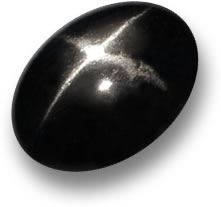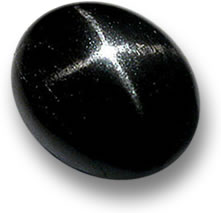Your Details
Your Details
|
Reviewed By Andreas Zabczyk
Star Diopside Gems: The Black Star of IndiaStar diopside is a captivating gemstone known for its unique optical phenomenon called asterism—a star-like pattern that appears to glide across the surface when viewed under direct light. Typically found in deep green to nearly black hues, star diopside is a variety of the mineral diopside that contains fine needle-like inclusions, often of magnetite, which reflect light in a distinctive four-rayed star. Sourced primarily from India, this lesser-known gem is gaining popularity for its natural beauty, metaphysical associations, and affordability. Discover our collection of star diopside gemstones for sale.  Star Diopside Cabochon
Like other forms of diopside, star diopside is composed of calcium magnesium silicate. It is fairly soft compared to most other gemstones with a hardness of just 5 to 6 on the Mohs scale. Therefore, its use in gemstone jewelry should be limited to cabochon earrings, pendants or star cabochon rings, and worn with care. Star diopside has an attractive vitreous luster and is normally cut into oval or round cabochons to maximize weight and chatoyancy. The cabochons are typically biconvex and the bottoms are left rough and unpolished. Star diopside has a specific gravity (density) ranging from 3.22 to 3.38 and a refractive index of 1.664 to 1.730. It belongs to the monoclinic crystal system and is known to form as columnar crystals. Star diopside has a very unique asterism compared to other types of star gemstone. It can also form with cat's eye chatoyancy, but asterism is more common. The white star can be easily seen against the dark diopside body color, and the asterism displayed is quite unique -- in that it only exhibits four rays; most star gemstones feature six-ray asterism, but star diopside's four rays are a result of its binary symmetry. In addition, star diopside's rays are crooked and slightly wavy because they are not at 90° right angles.  Star Diopside with Magnetite Inclusions
With star diopside, the needle-like inclusions responsible for the asterism are often visible from the surface of the stone. In fact, specimens are sometimes so heavily included with crystals of magnetite that they can be easily attracted to magnetic forces, since magnetite is the most magnetic mineral on Earth. Since it can carry such strong magnetism, star diopside is actually very popular for therapeutic use, particularly in crystal healing and metaphysical practices. Star diopside is often regarded not just for its visual allure but also for its deep spiritual resonance. In metaphysical circles, it is known as a stone of insight, healing, and connection to the Earth. Believed to open the heart and stimulate emotional healing, star diopside is frequently used in meditation and energy work to promote compassion, forgiveness, and the release of past trauma. Its grounding energy is said to help balance the body and mind, aligning the wearer with a sense of calm and inner peace. Additionally, the star-like asterism is thought to enhance intuition and inner vision, making it a favored stone for those seeking clarity or spiritual guidance. Whether worn as jewelry or kept as a pocket stone, star diopside is cherished for its potential to support emotional well-being and foster a deeper connection to the natural world. Today, most star diopside material comes from India, which is how it earned its nickname 'the Black Star of India'. However, smaller deposits of star diopside have been discovered in other areas, including Austria, Finland, Madagascar, Myanmar (Burma) South Africa, Sri Lanka and the United States. |
